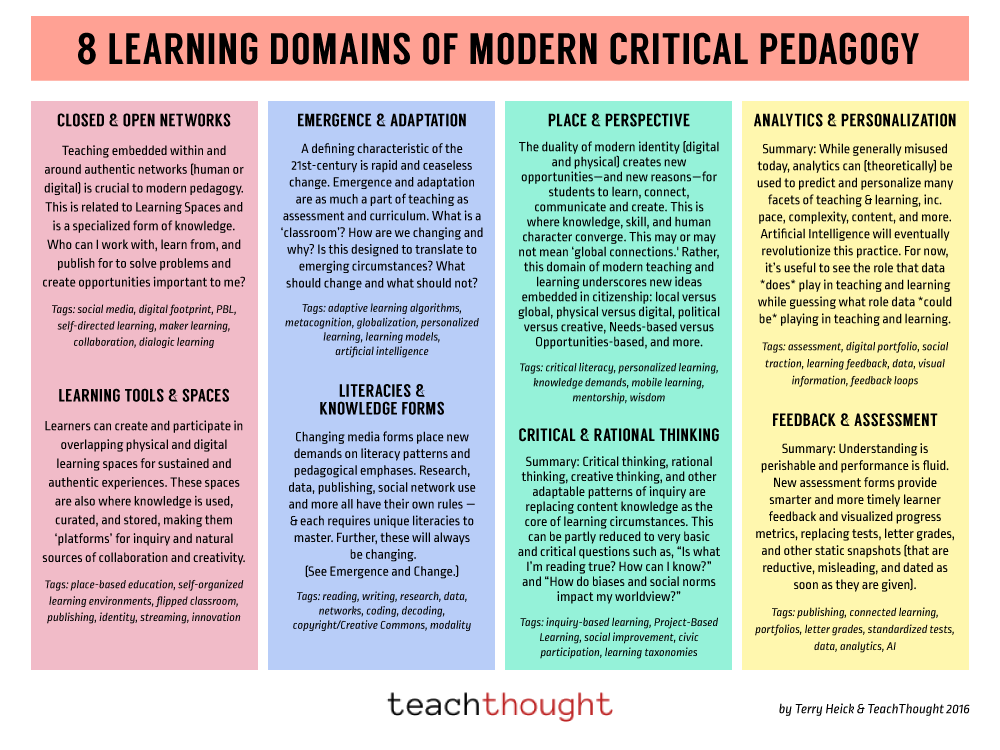
8 Learning Domains Of 21st Century Pedagogy
by Terry Heick
This has been updated and republished
How have teaching and learning changed?
What is 21st century pedagogy? What are its factors and characteristics and domains?
Aside from the sheer persistence of social media to modern themes of social justice, to added pressure on teachers for data-based improvements, and a persistent call for innovation for the field of education–how is teaching different today than it was in, say, 1983?
Here are a few ideas as a kind of quick overview, with general summaries for each. I’ve added ‘tags’ for each domain so that we can begin to see how existing and emerging initiatives (e.g., personalized learning), trends (e.g., the flipped classroom), and buzz words (e.g., digital footprint) might fit into each.
Obviously, these ideas are under-developed here because this is a blog post and not a book. My only hope is that this thinking can help frame your thinking a little–help clarify the elements and ‘players’ of modern pedagogy.
8 Domains Of 21st Century Pedagogy
Closed & Open Networks
Summary: Teaching embedded within and around authentic networks (human or digital) is crucial to modern pedagogy. This is related to Learning Spaces and is a specialized form of knowledge. Who can I work with, learn from and publish for to solve problems and create opportunities important to me?
Tags: social media, digital footprint, PBL, self-directed learning, maker learning, collaboration, dialogic learning
Learning Tools & Spaces
Summary: Learners can create and participate in overlapping physical and digital learning spaces for sustained and authentic experiences. These spaces are also where knowledge is used, curated, and stored, making them ‘platforms’ for inquiry and natural sources of collaboration and creativity.
Tags: place-based education, self-organized learning environments, flipped classroom, publishing, identity, streaming, innovation
Emergence & Adaptation
Summary: A defining characteristic of the 21st-century is rapid and ceaseless change. Emergence and adaptation are as much a part of teaching as assessment and curriculum. What is a ‘classroom’? How are we changing and why? Is this designed to translate to emerging circumstances? What should change and what should not?
Tags: adaptive learning algorithms, metacognition, globalization, personalized learning, learning models, artificial intelligence
Literacies & Knowledge Forms
Summary: Changing media forms place new demands on literacy patterns and pedagogical emphases. Research, data, publishing, social network use and more all have their own rules—& each requires unique literacies to master. Further, these will always be changing. (See Emergence and Change.)
Tags: reading, writing, research, data, networks, coding, decoding, copyright/Creative Commons, modality
Place & Perspective
Summary: The duality of modern identity (digital and physical) creates new opportunities—and new reasons—for students to learn, connect, communicate and create. This is where knowledge, skill, and human character converge. This may or may not mean ‘global connections.’ Rather, this domain of modern teaching and learning underscores new ideas embedded in citizenship: local versus global, physical versus digital, political versus creative, Needs-based versus Opportunities-based, and more.
Tags: critical literacy, personalized learning, knowledge demands, mobile learning, mentorship, wisdom
Critical & Rational Thinking
Summary: Critical thinking, rational thinking, creative thinking, and adaptable patterns of inquiry are replacing content knowledge as the core of learning circumstances. Adapting creative and ‘growth’ mindsets are also a part of this effort.
This can be partly reduced to very basic and critical questions such as, “Is what I’m reading true? How can I know?” and “How do biases and social norms impact my worldview?”
Tags: inquiry-based learning, Project-Based Learning, social improvement, civic participation, learning taxonomies
Analytics & Personalization
Summary: While generally misused today, analytics can (theoretically) be used to predict and personalize many facets of teaching & learning, inc. pace, complexity, content, and more. Artificial Intelligence will eventually revolutionize this practice. For now, it’s useful to see the role that data *does* play in teaching and learning while guessing what role data *could be* playing in teaching and learning.
Tags: assessment, digital portfolio, social traction, learning feedback, data, visual information, feedback loops
Feedback & Assessment
Summary: Understanding is perishable and performance is fluid. New assessment forms provide smarter and more timely learner feedback and visualized progress metrics, replacing tests, letter grades and other static snapshots (that are reductive, misleading, and dated as soon as they are given).
